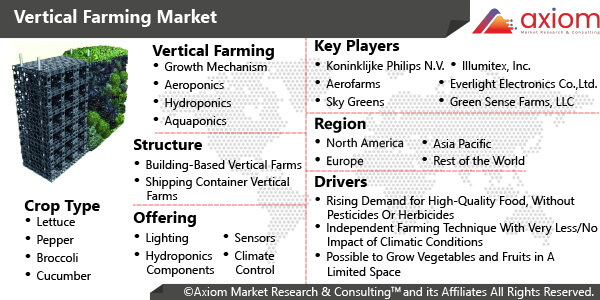Vertical farming is performed in indoor circumstances where vertically stacked trays are used to grow plants with the help of artificial lighting. This is being applied for manufacturing various crops such as cabbage, latus, and other leafy vegetables effectively. Vertical farming is considered to be more maintainable and revolutionary method of agriculture than traditional agriculture and greenhouse farming. It needs very less water and saves considerable soil and space. This farming method is useful in challenging environments such as mountainside towns, cities, and deserts.
Market Dynamics – Vertical farming Market
Growing population, the migration from rural to urban areas is also rising. Changing lifestyles, growing per capita income, and increasing health consciousness among consumers are driving the growth of the global vertical farming market. Similarly, the rising focus towards reliable production of crops irrespective of climatic conditions is driving the focus of farmers towards the environment welcoming production of fresh fruits and vegetables. Governments of several countries are also promoting the cultivation of organic food with the use of organic pesticides. These factors are anticipated to augment the growth of modern agriculture, and will accordingly drive the growth of the vertical farming industry.
ECONOMIC IMPACT OF COVID 19 ON VERTICAL FARMING MARKET
The exclusive COVID 19 impact analysis provides an analysis of micro and macro-economic factors on the Vertical farming market. Also, complete analysis of changes on healthcare expenditure, economic and international policies on supply and demand side. The report also studies the impact of the pandemic on global economies, international trade, business investments, GDP, and marketing strategies of key players present in the market.
VERTICAL FARMING MARKET - SEGMENTAL OVERVIEW
The study analysed the global vertical farming market based on offering, growth mechanism, structure, fruits & vegetable, and geography.
VERTICAL FARMING MARKET BY OFFERING
By offering, the market is segmented into hardware and software & service. Hardware segment includes lightning, hydroponic components, climate control, and sensors. The lightning segment is likely to dominate the market over the forecast period. Sunlight is an energetic resource in traditional farming. Though, vertical farming highly depends on artificial lights. Artificial light acts as a substitute for the sunlight and is required to provide sufficient light strengths that enable crop growth.
VERTICAL FARMING MARKET BY GROWTH MECHANISM
Hydroponic, aquaponic, and aeroponic are the major growth mechanism of the market. The hydroponic segment held a lion’s share in the market. The hydroponics growth mechanism is used generally by commercial growers. This mechanism is easier to set up, costs less than other mechanisms, and has a higher return on investments (ROI). In the hydroponic mechanism, in case of a power outage, the plants can live for a long time since the rising medium continues to supply water and nutrients, unlike aeroponics, where the plants can die in just a few hours due to malfunctioning or failure of haze spraying nozzles.
VERTICAL FARMING MARKET BY STRUCTURE
Building-based vertical farming and shipping container vertical farms are the structure of the market. The shipping container segment holds the largest market share and is expected to remain dominant during the forecast period. This growth is attributed to the capability of the structure to help grow crops irrespective of the geographic location. One of the main benefits of container-based farming is that container farms are easy to transport, and one doesn’t necessitate a large piece of land or a dedicated building to start cultivating.
VERTICAL FARMING MARKET BY FRUITS AND VEGETABLE
By fruits and vegetables, the market is categorised into tomatoes, lettuce, leafy vegetable, strawberry, cucumber, bell & chili peppers, and herbs. The tomatoes segment led the market and accounted for the highest revenue of the global market. This high share is attributable to the high average demand for tomatoes in all regions related to other crops such as lettuce, herbs, leafy greens, peppers, cucumbers, and so on.
VERTICAL FARMING MARKET BY GEOGRAPHY
Geographically, the study is comprised of the key countries of North America, Europe, Asia-Pacific, and the Rest of the World. The Asia Pacific is leading the global vertical farming market. Growing awareness concerning the importance of alternative farming, due to less availability of fertile agricultural land and growing population in the region, is the main factor expected to spur the demand.
VERTICAL FARMING MARKET KEY PLAYERS
The key competitor of the market includes 4D Bios Inc., Agrilution, Everlight Electronics Co., Ltd., Illumitex Inc., Urban Crop Solutions, Signify, Freight Farming, Plenty, Spread Co. Ltd, Osram, Sky Greens, Koninklijke Philips N.V., Hort Americas, AMHYDRO (American Hydroponics), AeroFarms, among others.











